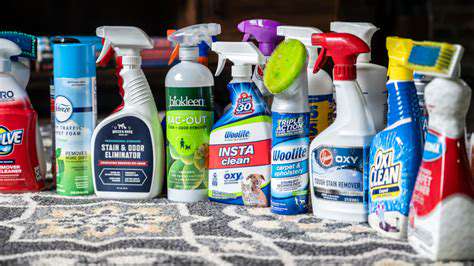Guide to Caring for Amphibians
Setting Up the Ideal Amphibian Habitat

Choosing the Right Enclosure
A crucial first step in creating the ideal amphibian habitat is selecting an appropriate enclosure. This isn't just about aesthetics; the enclosure's size, materials, and design directly affect the well-being of your amphibian. Consider the amphibian's size and natural behaviors when selecting the enclosure. A small enclosure might seem sufficient, but it won't provide the necessary space for the amphibian to thrive, potentially leading to stress and health problems. Larger enclosures allow for more natural behaviors and exploration, which is crucial for their overall health and happiness. Ensure the enclosure is made from non-toxic materials, as some substances can leach harmful chemicals into the environment.
The enclosure's size should be determined by the specific amphibian species. Researching the natural habitat of your chosen species is essential to determine the appropriate dimensions. This will help you replicate the key elements of their natural environment, such as vertical space, hiding places, and basking areas. A well-designed enclosure not only provides physical space but also promotes a sense of security and well-being for the amphibian. Remember to consider the enclosure's ventilation and ensure that it is properly sealed to prevent escapes and maintain a stable environment.
Creating the Ideal Substrate
The substrate you choose plays a vital role in maintaining a healthy and comfortable environment for your amphibian. It should be non-toxic, easy to maintain, and provide a suitable surface for burrowing or basking. A common choice is a mixture of soil, peat moss, and sand, tailored to the specific needs of the species. The substrate should be deep enough to allow the amphibian to burrow if it's a burrowing species.
Consider the amphibian's specific needs. Different species have varying substrate preferences. Some might prefer a loose, sandy substrate for burrowing, while others might prefer a more damp, mossy environment. Thorough research into your amphibian's natural habitat is essential to understanding their substrate needs. Ensure the substrate is cleaned and maintained regularly to prevent the buildup of harmful bacteria and odors. Proper maintenance of the substrate is critical for the overall health and well-being of your amphibian.
Providing Essential Water Features
Amphibians require access to water for hydration and, in some cases, reproduction. Providing a shallow water dish is essential, ensuring it's easily accessible and large enough for your amphibian to soak comfortably. The water should be changed regularly to prevent the buildup of bacteria and maintain cleanliness.
Beyond a simple water dish, consider adding a shallow pool or a humid area to mimic their natural environment. This will provide a crucial element for their health and well-being, replicating their natural environment. Maintaining a consistent moisture level is vital for the success of your amphibian's health and reproduction. Observe the species' natural behavior and tailor the water features to meet their needs.
Temperature and Lighting Considerations
Maintaining the appropriate temperature and lighting is crucial for the health and well-being of your amphibian. Research the specific temperature requirements of your chosen species. Replicating their natural environment is key to their comfort and survival. The temperature gradient is important to allow the amphibian to regulate its body temperature.
Lighting can also be an important consideration. Some amphibians require UVB lighting to synthesize vitamin D3. Understanding the specific needs of your amphibian is essential for their health. This may include heat lamps or other specialized lighting fixtures to maintain the proper temperature and light cycle. Observe your amphibian's behavior and adjust the environment as needed to ensure they are thriving.
Maintaining Water Quality and Hygiene

Maintaining Clean Water Sources
Ensuring the purity and safety of water sources is paramount for public health and environmental sustainability. Contamination from various sources, including industrial runoff, agricultural practices, and sewage, can quickly compromise water quality, leading to health risks and ecosystem damage. Implementing effective water quality monitoring programs is crucial for detecting and addressing these issues promptly. These programs should incorporate regular testing of key parameters like pH, turbidity, and the presence of harmful bacteria and chemicals. This proactive approach allows for timely interventions and prevents widespread contamination.
Protecting water sources from contamination requires a multi-faceted approach. This includes strict regulations on industrial discharge, promoting sustainable agricultural practices, and enhancing sewage treatment infrastructure. These measures are essential to prevent the introduction of pollutants into water bodies. Investing in technologies and strategies for water treatment and purification is also a critical component of maintaining clean water sources. This ensures that even after potential contamination, the water is safe for human consumption and use.
Safeguarding Public Health
Access to clean and safe drinking water is fundamental to human health and well-being. Contaminated water can harbor various pathogens, leading to waterborne diseases, which can have devastating consequences, especially in vulnerable populations. Preventing these diseases necessitates rigorous water treatment and purification processes. These processes should include disinfection methods that effectively eliminate harmful microorganisms. This is a crucial step in ensuring the safety of the water supply and safeguarding the health of the community.
Regular monitoring of water quality and immediate response to any detected contamination are critical components of public health protection. Rapid detection and mitigation of contamination threats are vital to minimizing the impact on human health. Furthermore, educating the public about proper water handling and hygiene practices is essential to prevent the spread of waterborne illnesses. This includes emphasizing the importance of boiling or treating water before consumption in areas with potential contamination risks.
Environmental Sustainability
Water quality is intrinsically linked to the health of aquatic ecosystems. Pollutants from various sources can severely impact the delicate balance of these ecosystems, harming fish populations, disrupting biodiversity, and degrading overall water quality. Protecting aquatic life and maintaining a healthy aquatic environment are essential for long-term ecological stability. This necessitates a focus on reducing pollution sources and implementing sustainable practices throughout the water cycle.
Sustainable water management practices are vital for preserving the health of aquatic ecosystems. These practices should encompass responsible agricultural practices, minimizing industrial discharge, and promoting water conservation. These efforts not only protect the environment but also contribute to the long-term sustainability of water resources for future generations.
Hygiene Practices and Water Quality
Maintaining proper hygiene practices plays a critical role in preventing water contamination. Individual actions, such as proper handwashing and safe disposal of waste, can significantly reduce the risk of waterborne diseases. These practices are essential in preventing the introduction of pathogens into water sources. Educating communities about these practices, particularly in areas with limited access to clean water and sanitation, is crucial.
Properly maintaining water storage containers and using appropriate water treatment methods are also essential aspects of maintaining water quality. This ensures that water remains safe for consumption and prevents contamination during storage. Implementing and enforcing hygiene standards at public facilities and ensuring the proper functioning of wastewater treatment plants are crucial aspects of maintaining water quality and hygiene. This is important to prevent contamination from entering the water supply.
Read more about Guide to Caring for Amphibians
Hot Recommendations
- Review: [Specific Brand] Small Animal Cage
- Why Rescuing Pets Saves Lives
- Best Pet First Aid Kits [What to Include]
- How to Help Stray Animals in Your Community
- Guide to Adopting a Pet When You Have Kids
- Top Reptile Heat Lamps
- Heartwarming Rescue Stories That Will Inspire You
- Review: [Specific Brand] Bird Cage
- Best Aquarium Filters [2025 Review]
- Review: [Specific Brand] Smart Litter Box






![A Vacation with My [Pet's Name] [Story]](/static/images/33/2025-06/ATriptoRemember.jpg)


